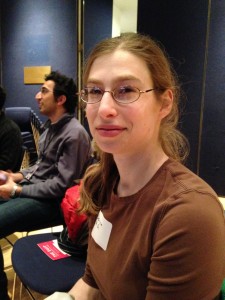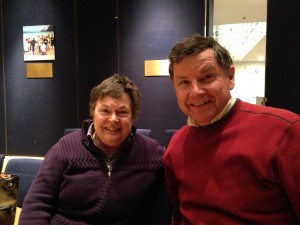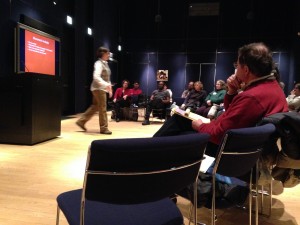UMS Night School: Bodies in Motion – Session 2 Recap
Editor’s note: This post is a part of a series of by U-M student Sarah Squillante, who’s covering our free UMS Night School: Bodies in Motion series. Learn along side with them.
What is dance? A rhythmic movement? Deliberately choreographed steps? Expression through time and space? What makes someone a good dancer?
This week’s UMS Night School session, held on Monday night, attempted to answer these tough questions and sparked a litany of others. It also welcomed its first guest speaker: U-M associate professor of Movement Science in the School of Kinesiology, Melissa Gross. Gross spoke about her research regarding the relationship between emotion and movement. Her area of study has focuses on mostly pedestrian movements, which have been found to correlate strongly with emotion. “Your emotions impact your body movement and your body movement can impact your emotions, too,” Gross said.
Attendees were invited to conceptualize movement a bit more scientifically, but this invitation quickly inspired questions that carried over to the dance world: How do we account for cultural differences in movement? Are certain people more in tune to others’ emotions (as expressed through movement) than others?
UMS Night School host, Clare Croft (assistant professor of dance at U-M), reminded everyone that this notion can be found everywhere in dance – Martha Graham’s work, for instance, was focused on the idea of translating emotion through motion in a universally accessible way.
Rebecca Rebhuhn (photo left), a U-M Graduate Student in mathematics, was a newcomer: “There aren’t many dance events in Ann Arbor, so I go to all that I can. I used to study dance academically and figured this could be interesting,” she said. Others were back for their second week.
Attendees Susan and Geoff Smereck (photo right) have seen numerous UMS dance performances together. They describe themselves as being “exuberant about dance. “Focusing on movement like we have allows me to not focus so much on the lack of a story line,” said Susan. “[Night School is] prying my brain open and giving me ways of thinking about movement.” Geoff wasn’t surprised by the thought-provoking nature of the evening’s discussions. “This is so U of M,” he said. “I’m looking for the vocabulary to conceptualize the dance performances that I see.”
PhD student Payam Mirghams and U-M graduate Sasha Kapshai share what inspired them to come to Night School.
The session, which was held the day after the Super Bowl, ended with a fitting video of former U-M quarterback Denard Robinson in action. Attendees were asked to describe the movement of football, and then to consider what we could learn from a culture or an idea through this movement.
Night School host Clare Croft demonstrates differences in movement.
Next week’s Night School, “Technique, Virtuosity, and Monsters,” will include a discussion of Moving Pictures, the upcoming U-M Department of Dance performance, and an introduction into hip-hop – just in time for Compagnie Käfig’s Correria Agwa on February 14 and 15. Special guests will include Reighan Gillam, a Postdoctoral research fellow in the U-M department of Afroamerican and African studies, and several U-M Dance Graduate Students. It will once again be held at the U-M Alumni Center at 200 Fletcher Street.
Session 2 Resources for Download
Session 3 prep reading on Capoeira – “Headspin” by Barbara Browning
Session 2 Powepoint Presentation by U-M Assistant Professor of Dance Clare Croft
Interested in even more dance engagement? Pick up an adventure card to learn all about the dance activities we’re offering this year and for a chance to win a backstage meet and greet.
For a complete list of 2013-2014 dance performances, visit ums.org. Share questions, comments, or suggestions in the comments below.









